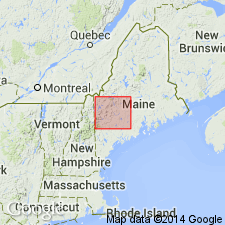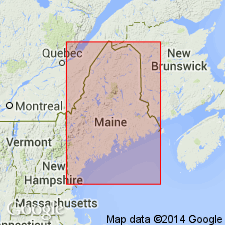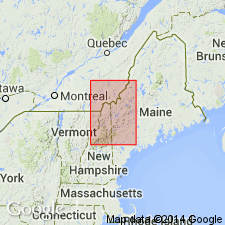
- Usage in publication:
-
- Sangerville Formation*
- Modifications:
-
- Revised
- Age modified
- AAPG geologic province:
-
- New England province
Summary:
Includes a principal facies of sandstone, shale, and siltstone. Also subdivided into (ascending) lower conglomerate lenses, lower limestone lenses, Patch Mountain Member, Anasagunticook Member, and upper conglomerate lenses. Includes all rocks previously mapped as Moody Brook Formation and Noyes Mountain Formation of Guidotti (1965) and Warner and Pankiwskyj (1965), and Turner Formation of Warner and Pankiwskyj (1965) all of which are here abandoned and are now recognized as parts of a single major sedimentary deposit defined as Sangerville. Age is Silurian, upper Llandovery to lower Ludlow.
Source: GNU records (USGS DDS-6; Reston GNULEX).

- Usage in publication:
-
- Sangerville Formation
- Modifications:
-
- Revised
- AAPG geologic province:
-
- New England province
Summary:
Sangerville Formation replaces Buckfield Group in Buckfield area. Divided (ascending): Moody Brook, Berry Ledge, Noyes Mountain, Patch Mountain, and Turner Members. Overlies Anasagunticook Member of Waterville Formation. [Intent to revise the above units is not stated, but subdivision of the Sangerville and its lower contact are clearly shown in stratigraphic column.] Order of younging within the Sangerville differs from reports of previous workers. Graded sequences suggest an inverted lithologic package. Rocks in report area have been subjected to three deformational events. Sangerville is Early and Middle Silurian. [Report appears to have been written without knowledge of Moench and Pankiwskyj (1988) who abandon Moody Brook, Noyes Mountain and Turner Members--see GNULEX Moench1988a.]
Source: GNU records (USGS DDS-6; Reston GNULEX).

- Usage in publication:
-
- Sangerville Formation*
- Modifications:
-
- Revised
- Age modified
- Biostratigraphic dating
- AAPG geologic province:
-
- New England province
Summary:
In central Maine trough, Sangerville Formation is mapped as principal sandstone and shale facies, and subdivided into (ascending) Patch Mountain Limestone Member (name revised from Patch Mountain Member to emphasize lithology), consisting of thinly interbedded impure marble, coarsely crystallized calc-silicate rocks, granofels, and pelitic schist (high metamorphic grade), or thinly interbedded, gray micritic metalimestone, limy metasandstone, metasiltstone, and slate or pelitic schist (low metamorphic grade); a conglomerate member; euxinic shale lenses; Taylor Pond Member of Hussey (1983), consisting of feldspathic biotite- and hornblende-biotite granofels, thinly bedded calc-silicate rocks, and sparse garnet-rich laminations (coticule); an unnamed limestone member similar to Patch Mountain Limestone Member but at a higher stratigraphic level; and Thorncrag Hill Member of Hussey (1983), consisting of migmatitic pelitic gneiss and some calc-silicate rocks. Anasagunticook Member of Pankiwskyj and others (1976) and Moench and Pankiwskyj (1988) is tentatively reassigned to Waterville Formation, following usage of Osberg (1988). Age is Silurian (Wenlockian) following Osberg (1988). Dated by graptolites found east of map area (Pankiwskyj and others, 1976; Moench and Pankiwskyj, 1988).
Source: GNU records (USGS DDS-6; Reston GNULEX).
For more information, please contact Nancy Stamm, Geologic Names Committee Secretary.
Asterisk (*) indicates published by U.S. Geological Survey authors.
"No current usage" (†) implies that a name has been abandoned or has fallen into disuse. Former usage and, if known, replacement name given in parentheses ( ).
Slash (/) indicates name conflicts with nomenclatural guidelines (CSN, 1933; ACSN, 1961, 1970; NACSN, 1983, 2005, 2021). May be explained within brackets ([ ]).

